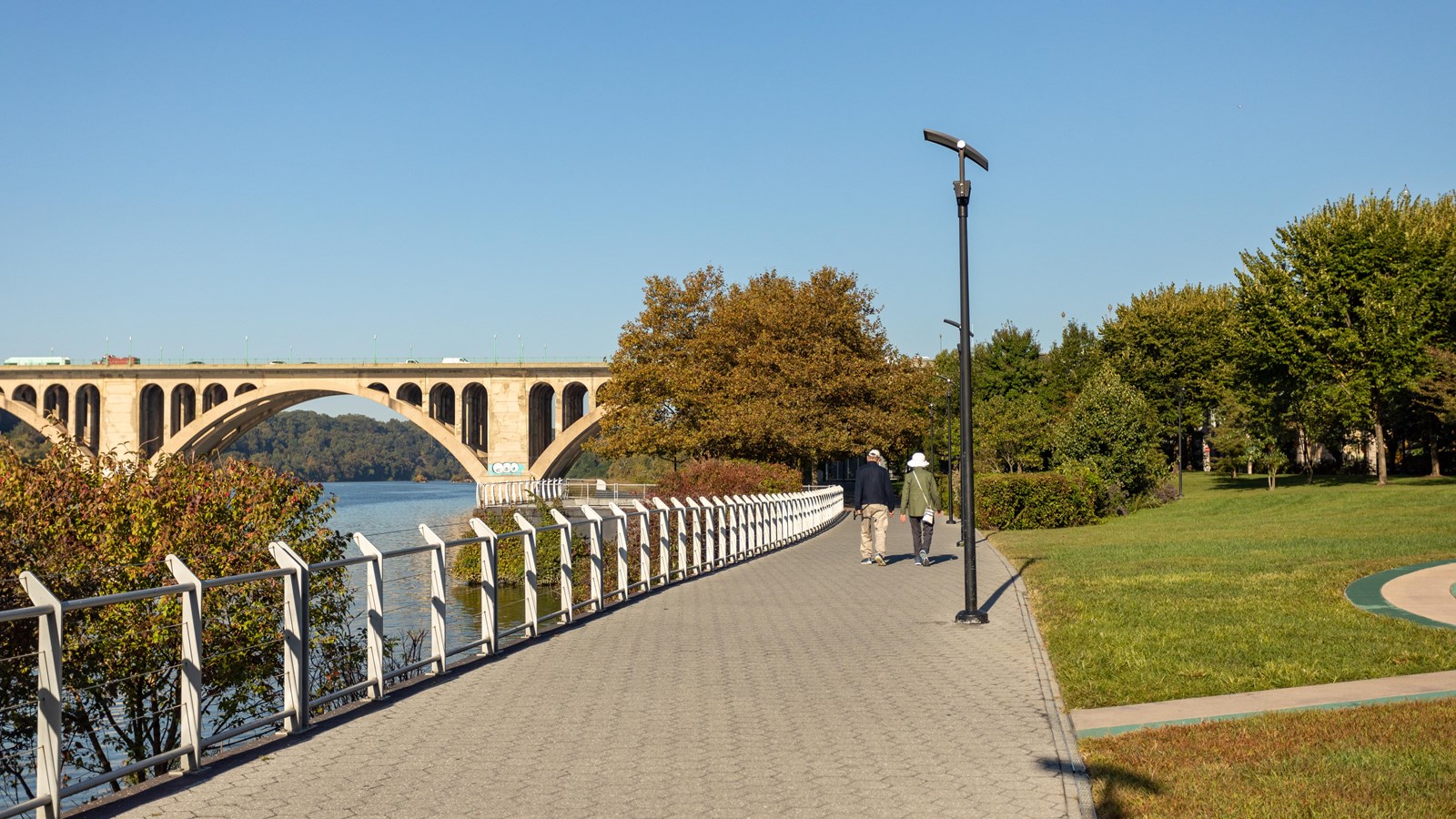Last updated: October 10, 2024
Place
Georgetown Waterfront Park

NPS / Claire Hassler
Accessible Sites, Beach/Water Access, Benches/Seating, Bicycle - Rack, Bicycle - Rental, Bicycle - Repair, Bicycle - Sharing Station, Boat Ramp, Bus/Shuttle Stop, Canoe/Kayak/Small Boat Launch, Cellular Signal, Historical/Interpretive Information/Exhibits, Public Transit, Recycling, Scenic View/Photo Spot, Trash/Litter Receptacles, Wheelchair Accessible
Georgetown Waterfront Park, stretching along the banks of the Potomac River from 31st Street, NW to the Key Bridge, was completed in the fall of 2011. The park links 225 miles of parkland along the Potomac River stretching from Cumberland, Maryland, to Mount Vernon, Virginia. The park is beloved by many due to its notable design elements like the labyrinth, beautiful fountain (seasonal, open "Alerts" at top of page for status), and charming rain gardens. Visitors come to the park to enjoy quiet contemplation or to take advantage of the large accessible pathways to exercise and recreate. Cyclists, skaters, and pedestrians have a designated pathway (free of cars) allowing them to enjoy views of individual boaters, kayakers, and competitive crews, as well as of Theodore Roosevelt Island, Key Bridge, and the Potomac River. The park has many unique design features including:
Looking for peace of mind? You might find it in the labyrinth at the western end of the park. Labyrinths date back to ancient times. Geometric turns are meant to encourage contemplation as you slowly travel from the outer edge into the center. To get the most out of the walk, focus on quieting your mind and disconnecting with the chaos of the outside world.
Fountain (seasonal, open "Alerts" at top of page for status)
The centerpiece of the park is the fountain found at the waterfront intersection of Wisconsin Avenue, NW, and K Street. People of all ages enjoy splashing and playing in the water on hot summer days.
River Steps and Pergola
These steps were originally created with rowing regattas in mind. In addition to providing finish line seating for rowing events, the steps are a popular year-round place to picnic while viewing the river, birds, other wildlife, and boaters. More seating can be found beneath the tall steel and cable pergola, designed as a call back to the waterfront’s more industrial past.
The waterfront was once a dynamic center of commerce and trade, especially for tobacco. But by the 1820s, larger ships could no longer access the river due to the build-up of silt. Factories like the American Ice Company and the Brennan Construction Company transformed the waterfront port into an industrial landscape. The area became a transportation route when the construction was completed for nearby Key Bridge and the Whitehurst Freeway. As a result of this new shift, the once booming factories began to relocate or close, and much of the waterfront was converted into parking lots.
Today, the Georgetown Waterfront Park preserves public open space and the waterfront’s history.
Rain Gardens
The rain gardens are located at the intersection of the paths that cross the park. Rain gardens collect and hold rainwater and storm water runoff, so it can soak into the ground instead of flowing into storm drains or along the surface of the land. Rain gardens help prevent erosion, water pollution, and flooding.
Bio-Edge
Looking at the edge of the waterfront, you will see a living bank where a crumbling concrete retaining wall used to be. Instead of simply repairing the beat-up bulkhead from the industrial era, the National Park Service added soil and native plants. This greener solution was engineered to stabilize the bank, create a habitat for wildlife, and filter rainwater as it flows from the park to the river.
Pollinator Gardens
Can you imagine a world without flowers? Over 75% of the Earth’s flowering plants depend on pollinators for reproduction. Despite their importance, studies show that pollinator populations are declining due to loss of habitat. Pollinator gardens, big or small, help keep pollinators strong by providing a place to eat, rest, and reproduce.
At this park, you can find pollinator gardens with native plants along the pathways at both Potomac Street and 33rd Street. Funding for these two gardens was provided by the Friends of Georgetown Waterfront Park.
